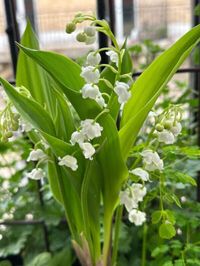As the tradition of gifting lily of the valley, or muguet, flourishes every May 1st in France, a stark warning accompanies its beauty. While these delicate, white bell-shaped flowers symbolize spring and good luck, they also harbor significant dangers for both humans and pets.
Published on May 1, 2025, various reports highlight the alarming toxicity of lily of the valley, particularly for pets. All parts of the plant—stems, leaves, flowers, berries, and even the water in which the bouquet is placed—contain cardiotonic heterosides. These compounds can lead to serious health issues, including nausea, vomiting, and even cardiac arrest if ingested in significant amounts.
Veterinary emergency services have issued warnings, noting that lily of the valley is “extremely toxic” to dogs and cats. According to Dr. Pierre Fabing, a veterinary emergency specialist, this plant accounts for nearly 20% of all plant poisoning cases annually. “Eating a small bell or even drinking the water from the vase can have severe consequences for an animal,” he explained.
The symptoms of poisoning in pets can manifest quickly, typically within 15 minutes to six hours after ingestion. Signs of distress include unusual salivation, vomiting, diarrhea, prostration, and alterations in heart rate, which can escalate to cardiac arrest or convulsions. Dr. Fabing cautioned, “The symptoms may not appear immediately, making it difficult to connect the ingestion to the resulting health issues.”
As the festivities of May Day encourage the display of these flowers in homes, pet owners are urged to exercise caution. The veterinary service 3115 advises against leaving bouquets within reach of animals and recommends discarding wilted plants and vase water promptly. “If you suspect your pet has ingested muguet, contact your veterinarian immediately,” they stated. “There is no specific antidote for lily of the valley poisoning, and treatment focuses on managing symptoms.”
Furthermore, the dangers are not limited to pets. Humans can also experience adverse effects from lily of the valley. Ingestion can lead to digestive disturbances such as mouth irritation, abdominal pain, nausea, vomiting, and diarrhea. The Lille Poison Control Center has noted additional symptoms including drowsiness, breathing difficulties, and even convulsions.
Parents are particularly advised to keep this flower out of reach of children, who may be more susceptible to its toxic effects. All parts of the plant are harmful, including the berries and the water in which the flowers have been placed. In case of ingestion, contacting a poison control center or a medical professional is strongly recommended.
Despite its charm and association with good fortune, lily of the valley presents a duality that pet owners and parents must recognize. Dr. Fabing emphasized, “Lily of the valley is not inherently dangerous as long as it remains out of reach. However, if you have a curious animal at home, it’s best to avoid bringing it into your space altogether.”
As the tradition of gifting lily of the valley continues, awareness of its toxic properties is crucial. The veterinary community encourages all pet owners to be vigilant and proactive in preventing accidental poisonings. With the right precautions, the joy of May Day can be celebrated without the shadow of danger lurking in the form of these beautiful but deadly flowers.
In summary, the message is clear: while lily of the valley may be a beloved symbol of spring, it is essential to handle it with care. Keeping these flowers out of reach and being aware of the symptoms of poisoning can help ensure a safe and happy May Day for all.






